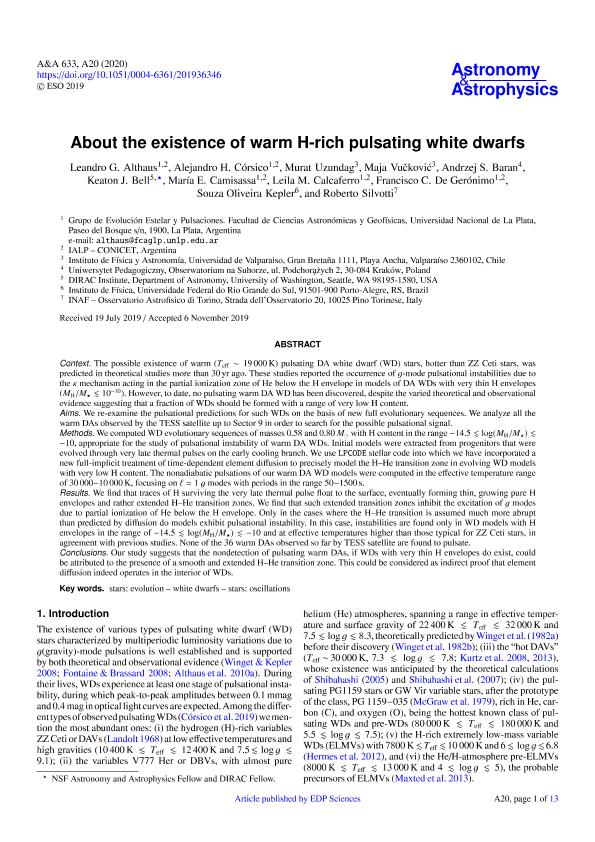Mostrar el registro sencillo del ítem
dc.contributor.author
Althaus, Leandro Gabriel

dc.contributor.author
Corsico, Alejandro Hugo

dc.contributor.author
Uzundag, Murat

dc.contributor.author
Vucković, Maja
dc.contributor.author
Baran, Andrzej S.
dc.contributor.author
Bell, Keaton J.
dc.contributor.author
Camisassa, María Eugenia

dc.contributor.author
Calcaferro, Leila Magdalena

dc.contributor.author
de Gerónimo, Francisco César

dc.contributor.author
Kepler, Souza Oliveira
dc.contributor.author
Silvotti, Roberto
dc.date.available
2021-08-23T15:30:19Z
dc.date.issued
2020-01
dc.identifier.citation
Althaus, Leandro Gabriel; Corsico, Alejandro Hugo; Uzundag, Murat; Vucković, Maja; Baran, Andrzej S.; et al.; About the existence of warm H-rich pulsating white dwarfs; EDP Sciences; Astronomy and Astrophysics; 633; A20; 1-2020; 1-13
dc.identifier.issn
0004-6361
dc.identifier.uri
http://hdl.handle.net/11336/138700
dc.description.abstract
Context. The possible existence of warm (Teff ∼ 19 000 K) pulsating DA white dwarf (WD) stars, hotter than ZZ Ceti stars, was predicted in theoretical studies more than 30 yr ago. These studies reported the occurrence of g-mode pulsational instabilities due to the κ mechanism acting in the partial ionization zone of He below the H envelope in models of DA WDs with very thin H envelopes (MH/M⋆ ≲ 10-10). However, to date, no pulsating warm DA WD has been discovered, despite the varied theoretical and observational evidence suggesting that a fraction of WDs should be formed with a range of very low H content. Aims: We re-examine the pulsational predictions for such WDs on the basis of new full evolutionary sequences. We analyze all the warm DAs observed by the TESS satellite up to Sector 9 in order to search for the possible pulsational signal. Methods: We computed WD evolutionary sequences of masses 0.58 and 0.80 M☉ with H content in the range -14.5 ≲ log(MH/M⋆)≲ - 10, appropriate for the study of pulsational instability of warm DA WDs. Initial models were extracted from progenitors that were evolved through very late thermal pulses on the early cooling branch. We use LPCODE stellar code into which we have incorporated a new full-implicit treatment of time-dependent element diffusion to precisely model the H-He transition zone in evolving WD models with very low H content. The nonadiabatic pulsations of our warm DA WD models were computed in the effective temperature range of 30 000 - 10 000 K, focusing on ℓ = 1 g modes with periods in the range 50 - 1500 s. Results: We find that traces of H surviving the very late thermal pulse float to the surface, eventually forming thin, growing pure H envelopes and rather extended H-He transition zones. We find that such extended transition zones inhibit the excitation of g modes due to partial ionization of He below the H envelope. Only in the cases where the H-He transition is assumed much more abrupt than predicted by diffusion do models exhibit pulsational instability. In this case, instabilities are found only in WD models with H envelopes in the range of -14.5 ≲ log(MH/M⋆)≲ - 10 and at effective temperatures higher than those typical for ZZ Ceti stars, in agreement with previous studies. None of the 36 warm DAs observed so far by TESS satellite are found to pulsate. Conclusions: Our study suggests that the nondetection of pulsating warm DAs, if WDs with very thin H envelopes do exist, could be attributed to the presence of a smooth and extended H-He transition zone. This could be considered as indirect proof that element diffusion indeed operates in the interior of WDs.
dc.format
application/pdf
dc.language.iso
eng
dc.publisher
EDP Sciences

dc.rights
info:eu-repo/semantics/openAccess
dc.rights.uri
https://creativecommons.org/licenses/by-nc-sa/2.5/ar/
dc.subject
stars: evolution
dc.subject
white dwarfs
dc.subject
stars: oscillations
dc.subject.classification
Astronomía

dc.subject.classification
Ciencias Físicas

dc.subject.classification
CIENCIAS NATURALES Y EXACTAS

dc.title
About the existence of warm H-rich pulsating white dwarfs
dc.type
info:eu-repo/semantics/article
dc.type
info:ar-repo/semantics/artículo
dc.type
info:eu-repo/semantics/publishedVersion
dc.date.updated
2021-08-17T15:54:22Z
dc.journal.volume
633
dc.journal.number
A20
dc.journal.pagination
1-13
dc.journal.pais
Francia

dc.journal.ciudad
Paris
dc.description.fil
Fil: Althaus, Leandro Gabriel. Universidad Nacional de La Plata. Facultad de Ciencias Astronómicas y Geofísicas; Argentina. Consejo Nacional de Investigaciones Científicas y Técnicas. Centro Científico Tecnológico Conicet - La Plata. Instituto de Astrofísica La Plata. Universidad Nacional de La Plata. Facultad de Ciencias Astronómicas y Geofísicas. Instituto de Astrofísica La Plata; Argentina
dc.description.fil
Fil: Corsico, Alejandro Hugo. Universidad Nacional de La Plata. Facultad de Ciencias Astronómicas y Geofísicas; Argentina. Consejo Nacional de Investigaciones Científicas y Técnicas. Centro Científico Tecnológico Conicet - La Plata. Instituto de Astrofísica La Plata. Universidad Nacional de La Plata. Facultad de Ciencias Astronómicas y Geofísicas. Instituto de Astrofísica La Plata; Argentina
dc.description.fil
Fil: Uzundag, Murat. Universidad de Valparaíso; Chile
dc.description.fil
Fil: Vucković, Maja. Universidad de Valparaíso; Chile
dc.description.fil
Fil: Baran, Andrzej S.. Obserwatorium na Suhorze; Polonia
dc.description.fil
Fil: Bell, Keaton J.. University of Whashington; Estados Unidos
dc.description.fil
Fil: Camisassa, María Eugenia. Universidad Nacional de La Plata. Facultad de Ciencias Astronómicas y Geofísicas; Argentina. Consejo Nacional de Investigaciones Científicas y Técnicas. Centro Científico Tecnológico Conicet - La Plata. Instituto de Astrofísica La Plata. Universidad Nacional de La Plata. Facultad de Ciencias Astronómicas y Geofísicas. Instituto de Astrofísica La Plata; Argentina
dc.description.fil
Fil: Calcaferro, Leila Magdalena. Universidad Nacional de La Plata. Facultad de Ciencias Astronómicas y Geofísicas; Argentina. Consejo Nacional de Investigaciones Científicas y Técnicas. Centro Científico Tecnológico Conicet - La Plata. Instituto de Astrofísica La Plata. Universidad Nacional de La Plata. Facultad de Ciencias Astronómicas y Geofísicas. Instituto de Astrofísica La Plata; Argentina
dc.description.fil
Fil: de Gerónimo, Francisco César. Universidad Nacional de La Plata. Facultad de Ciencias Astronómicas y Geofísicas; Argentina. Consejo Nacional de Investigaciones Científicas y Técnicas. Centro Científico Tecnológico Conicet - La Plata. Instituto de Astrofísica La Plata. Universidad Nacional de La Plata. Facultad de Ciencias Astronómicas y Geofísicas. Instituto de Astrofísica La Plata; Argentina
dc.description.fil
Fil: Kepler, Souza Oliveira. Universidade Federal do Rio Grande do Sul; Brasil
dc.description.fil
Fil: Silvotti, Roberto. Osservatorio Astrofisico Di Torino; Italia
dc.journal.title
Astronomy and Astrophysics

dc.relation.alternativeid
info:eu-repo/semantics/altIdentifier/url/https://www.aanda.org/10.1051/0004-6361/201936346
dc.relation.alternativeid
info:eu-repo/semantics/altIdentifier/doi/https://doi.org/10.1051/0004-6361/201936346
Archivos asociados
